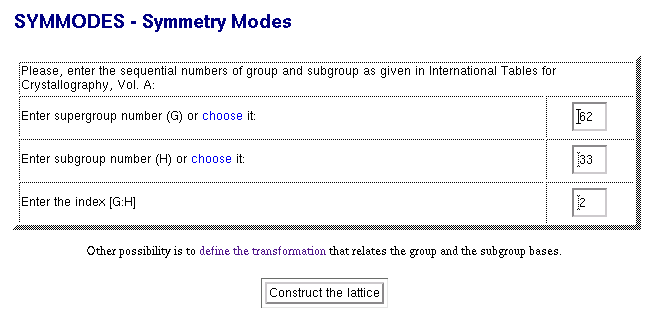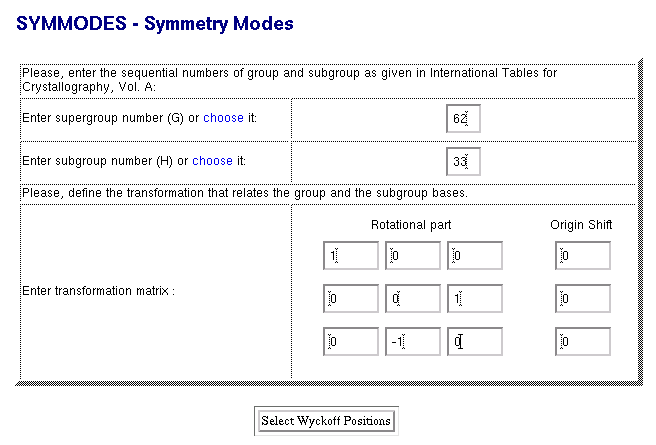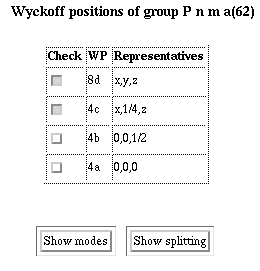 SYMMODES
SYMMODES
 Help
Help
Bilbao Crystallographic Server
 SYMMODES SYMMODES
 Help Help
|
The software package SYMMODES (Symmetry Modes) provides the necessary tools for a group-theoretical analysis of a structural phase transition characterized by a symmetry change G-H, with G > H. The package combines modules of the programs SUBGROUPGRAPH, WYCKSPLIT and the program SOPD (Subgroup Graph Order-Parameter Displacements). The latter has been developed by H. Stokes and D. Hatch (Brigham Young University, Utah, USA) and is a dedicated segment of the package ISOTROPY.
Step 1:Identification of the group-subgroup pair.
Example: (option 1)
| Supergroup Number | 62 |
| Subgroup Number | 33 |
| Index | 2 |
This is the look and feel of the first form in the option 1. The user must specify the supergroup(G) and subgroup(H) numbers and the index [i].

Given the space groups G, H and their index, the program returns a list of all possible subgroups Hj (of the space group type H) with this index. Each subgroup is specified by the transformation matrix relating its basis to that of G. Different transformation matrices leading to the same subgroup Hj are listed under 'Identical'. The subgroups Hj are distributed into classes of conjugate subgroups. The user is expected to check from the list the relevant subgroup Hj.

Example: (option 2)
| Supergroup Number | 62 | |
| Subgroup Number | 33 | |
| Transformation Matrix | 1 0 0 0 0 0 1 0 0 -1 0 0 |
This is the look and feel of the first form in option 2. The user must specify the supergroup(G) and subgroup(H) ITA numbers and the transformation matrix that relates the bases of G and H.

Step 2: Wyckoff Positions of the high-symmetry structure
Given the group-subgroup pair G > H, the program returns a list of the Wyckoff positions of G. The user is expected those Wyckoff positions which correspond to the occupied orbits of G.
Example:
G = Pnma and occupied Wyckoff positions 8d and 4c.

The results of the symmetry analysis can be summarized as follows:
Example: To see the results for the symmetry break Pnma > Pna21 with index 2, click here.
Example: Symmetry modes for the group-subgroup pair Pnma > Pna21, index 2 and Wyckoff positions 8d, 4c.
| Irrep | GM1+ |
| Order Parameter | (a) |
| Isotropy Subgroup H | 62 Pnma D2h-16 |
| Transformation Matrix | [ 1 0 0 ] [ 0] [ 0 1 0 ] [ 0] [ 0 0 1 ] [ 0] |
| WP 8d | Displacements | ||
|---|---|---|---|
| (x,y,z) | (1,0,0) | (0,1,0) | (0,0,1) |
| (x+1/2,-y+1/2,-z+1/2) | (1,0,0) | (0,-1,0) | (0,0,-1) |
| (-x,y+1/2,-z) | (-1,0,0) | (0,1,0) | (0,0,-1) |
| (-x+1/2,-y,z+1/2) | (-1,0,0) | (0,-1,0) | (0,0,1) |
| (-x,-y,-z) | (-1,0,0) | (0,-1,0) | (0,0,-1) |
| (-x+1/2,y+1/2,z+1/2) | (-1,0,0) | (0,1,0) | (0,0,1) |
| (x,-y+1/2,z) | (1,0,0) | (0,-1,0) | (0,0,1) |
| (x+1/2,y,-z+1/2) | (1,0,0) | (0,1,0) | (0,0,-1) |
| WP 4c | Displacements | |
|---|---|---|
| (x,1/4,z) | (1,0,0) | (0,0,1) |
| (x+1/2,1/4,-z+1/2) | (1,0,0) | (0,0,-1) |
| (-x,3/4,-z) | (-1,0,0) | (0,0,-1) |
| (-x+1/2,-1/4,z+1/2) | (-1,0,0) | (0,0,1) |
| Irrep | GM4- |
| Order Parameter | (a) |
| Isotropy Subgroup H | 33 Pna2_1 C2v-9 |
| Transformation Matrix | [ 1 0 0 ] [ 0] [ 0 0 1 ] [ 0] [ 0 -1 0 ] [ 0] |
| WP 8d | Displacements | ||
|---|---|---|---|
| (x,y,z) | (1,0,0) | (0,1,0) | (0,0,1) |
| (x+1/2,-y+1/2,-z+1/2) | (-1,0,0) | (0,1,0) | (0,0,1) |
| (-x,y+1/2,-z) | (-1,0,0) | (0,1,0) | (0,0,-1) |
| (-x+1/2,-y,z+1/2) | (1,0,0) | (0,1,0) | (0,0,-1) |
| (-x,-y,-z) | (1,0,0) | (0,1,0) | (0,0,1) |
| (-x+1/2,y+1/2,z+1/2) | (-1,0,0) | (0,1,0) | (0,0,1) |
| (x,-y+1/2,z) | (-1,0,0) | (0,1,0) | (0,0,-1) |
| (x+1/2,y,-z+1/2) | (1,0,0) | (0,1,0) | (0,0,-1) |
| WP 4c | Displacements |
|---|---|
| (x,1/4,z) | (0,1,0) |
| (x+1/2,1/4,-z+1/2) | (0,1,0) |
| (-x,3/4,-z) | (0,1,0) |
| (-x+1/2,-1/4,z+1/2) | (0,1,0) |
For each one of the selected Wyckoff positions of G, the program returns
Example: Splitting scheme of the Wyckoff position 8d for the symmetry break Pnma > Pna21.
| Representative | Subgroup Wyckoff position | |||
|---|---|---|---|---|
| No | group basis | subgroup basis | name[n] | representative |
| 1 | (x, y, z ) | (x, y, z ) | 4a1 | (x1, y1, z1 ) |
| 2 | (-x, y+1/2, -z ) | (-x, -y, z+1/2 ) | (-x1, -y1, z1+1/2 ) | |
| 3 | (x+1/2, y, -z-1/2 ) | (x+1/2, -y+1/2, z ) | (x1+1/2, -y1+1/2, z1 ) | |
| 4 | (-x+1/2, y+1/2, z-1/2 ) | (-x+1/2, y+1/2, z+1/2 ) | (-x1+1/2, y1+1/2, z1+1/2 ) | |
| 5 | (-x+1/2, -y, z-1/2 ) | (-x+1/2, y+1/2, -z ) | 4a2 | (x2, y2, z2 ) |
| 6 | (x+1/2, -y+1/2, -z-1/2 ) | (x+1/2, -y+1/2, -z+1/2 ) | (-x2, -y2, z2+1/2 ) | |
| 7 | (-x, -y, -z ) | (-x, -y, -z ) | (x2+1/2, -y2+1/2, z2 ) | |
| 8 | (x, -y+1/2, z ) | (x, y, -z+1/2 ) | (-x2+1/2, y2+1/2, z2+1/2 ) | |
|
Bilbao Crystallographic Server (http://www.cryst.ehu.es) |
For comments, please mail to administrador.bcs@ehu.es |